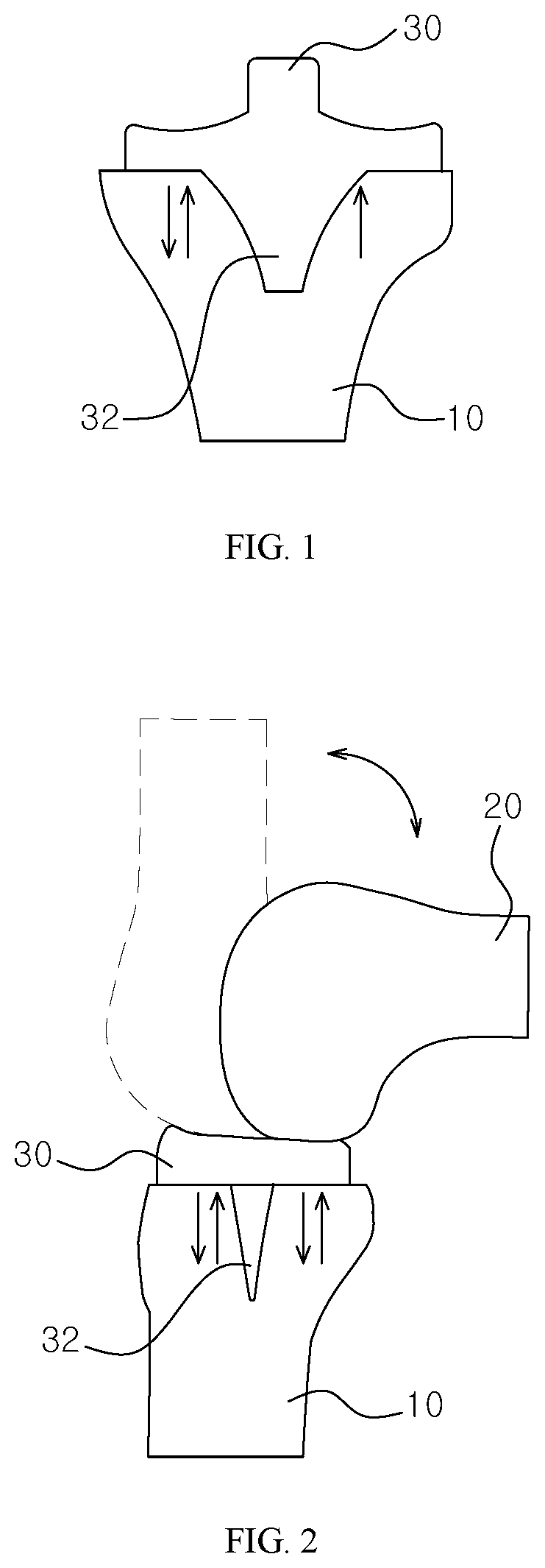Resection guide, trial knee joint implant, and surgical instrument for knee arthroplasty
a knee joint implant and surgical instrument technology, applied in the field of knee joint surgery surgical instruments, can solve the problems of insufficient support for forces generated, increased number of patients with knee joints that are incurably damaged, and increased risk of quadriceps femoris weakening
- Summary
- Abstract
- Description
- Claims
- Application Information
AI Technical Summary
Benefits of technology
Problems solved by technology
Method used
Image
Examples
first embodiment
[0106]With reference to FIGS. 8, 10A and 10B, a resection guide 1 according to the present invention is used for resection of a proximal end of a tibia during total knee arthroplasty (TKA). The resection guide 1 includes a main body 11 and two fixing pins 13.
[0107]The main body 11, as illustrated in FIGS. 10A and 10B, is arranged on an anterior surface of a proximal end of a tibia 10 such that the proximal end of the tibia 10 is resected by a resection device (not illustrated). The main body 11 includes a guide portion 111 formed to pass through the main body 11, a window 113, and two auxiliary pin insertion holes 115.
[0108]The guide portion 111 includes a slot 1111 that guides movement of the resection device and two pin insertion holes 1113 formed to communicate with the slot 1111 such that the fixing pins 13 can be inserted into the pin insertion holes 1113, respectively.
[0109]The slot 1111 transversely extends across the main body 11 and guides the resection device such that the...
second embodiment
[0131]With reference to FIGS. 16 and 17, a resection guide 3 according to the present invention will be described. The resection guide 3 is used to guide resection of a proximal end of a tibia during unicompartmental knee arthroplasty (UKA). The resection guide 3 includes a main body 31 and a fixing pin 33.
[0132]The main body 31 is a component to be arranged on the anterior surface of a proximal end of a tibia 10 to guide a resection device (not illustrates) that resects the proximal end of the tibia 10. The main body 31 includes a guide portion 311 formed to pass through the main body 31, a window 313, and an auxiliary pin insertion hole 315.
[0133]The guide portion 311 includes a slot 4111 that guides movement of the resection device and a pin insertion hole 311 that is formed to communicate with the slot 3111 and into which the fixing pin 33 is inserted.
[0134]The slot 3111 extends in a medial-lateral direction, and an end of the slot 3111 in a direction along which the resection d...
third embodiment
[0148]With reference to FIG. 22, a resection guide 5 according to the present invention will be described. The resection guide 5 is used to guide resection of a distal end of a femur during UKA or TKA surgery, and includes a main body 51 and a fixing pin 53.
[0149]The main body 51 is arranged on the lateral surface or the medial surface of the distal end of the femur 20 such that the distal end of the femur 20 is resected by a resection device (not illustrated). The main body 51 includes a guide portion 511 formed to pass through the main body 51.
[0150]The guide portion 511 includes a slot 5111 that guides movement of the resection device and a pin insertion hole 5113 that is formed to communicate with the slot 5111 and into which a fixing pin 51 is inserted.
[0151]The slot 5111 includes a first slot 51111 vertically extending across the main body 51, a second slot 51113 extending toward a posterior side of the main body 51 from a lower end of the first slot 51111, and a third slot 51...
PUM
 Login to View More
Login to View More Abstract
Description
Claims
Application Information
 Login to View More
Login to View More - R&D
- Intellectual Property
- Life Sciences
- Materials
- Tech Scout
- Unparalleled Data Quality
- Higher Quality Content
- 60% Fewer Hallucinations
Browse by: Latest US Patents, China's latest patents, Technical Efficacy Thesaurus, Application Domain, Technology Topic, Popular Technical Reports.
© 2025 PatSnap. All rights reserved.Legal|Privacy policy|Modern Slavery Act Transparency Statement|Sitemap|About US| Contact US: help@patsnap.com



